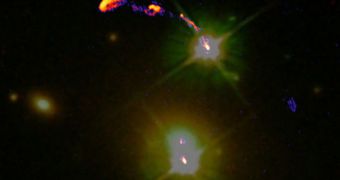Astronomers in the United Kingdom have recently started the e-Merlin telescope array, which is the newest to be opened in the country. As part of the observatory's first light studies, experts were able to study the jet emissions of a supermassive black holes.
The jets the team analyzed were coming from the highly active and distant core of a large galaxy, whose central regions usually harbor black holes. The fact that the newly-commissioned telescope was able to find these structures was an achievement in itself.
Astronomers usually call the cores of active galaxies quasars, which stands for quasi-stellar radio sources. These objects are capable of releasing impressive jets of radiation from their poles, and are also some of the most luminous bodies in the entire Universe.
The jets then go on to Arch over thousands of light-years, producing amazing displays of force throughout the Universe. Such a structure was detected recently with e-Merlin.
The quasar that spawned the jet lies some 9 billion light-years away from Earth, which means that it was formed some 4.7 billion years after the Big Bang.
According to experts, the object that e-Merlin analyzed recently is called the Double Quasar, but not because it's a weird structure or anything, but because we see it through a gravitational lens.
In other words, a foreground galaxy, located between our vantage point and the distant quasar, is bending light produced by the active galactic core, forcing us to view the object as if through a magnifying glass.
This phenomenon, called gravitational lensing, has earned the distant structure the name Double Quasar, as the cosmic lens is producing multiple images of it, Space reports.
“This first image of the Double Quasar clearly demonstrates how useful e-Merlin is going to be in our studies of gravitational lenses,” explains researcher Neal Jackson.
“By mapping the bending of light by mass, we will be able to study the way in which both stars and dark matter are distributed in galaxies and how this changes as the Universe evolves,” he adds.
The expert holds an appointment at the University of Manchester. He explains that e-Merlin will basically be acting as the UK's national facility for radio astronomy.
He adds that the most distant telescopes in the array are as much as 137 miles (220 kilometers). At this point, there are 7 observatories, although plans include a low mote.
“We are very much looking forward to the new scientific results that will flow from the telescope over the coming years,” explains UM official and the Director of E-Merlin, Simon Garrington.

 14 DAY TRIAL //
14 DAY TRIAL //